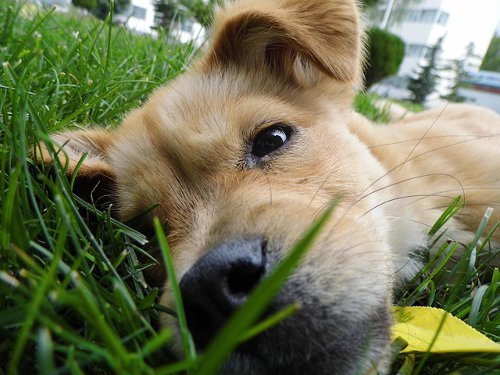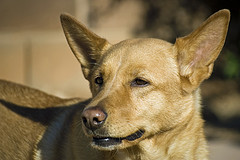|
When you meet a new person, what do you do? Look them in the eye, smile, maybe reach out for a handshake? That works fine for humans, but all three of those actions would be threatening to a dog. So how does dog body language translate to human terms?
There are two parts to understand: the meaning of the body language itself and the context. Some signals can be good or bad, so to know which one it is you have to look at other signals you’re getting alongside it. Your dog is trying to tell you something. Let’s look at some common body language signs you dog may be sending, starting from front to back.

Bared teeth:
If the teeth are shown in a “submissive grin,” with the lips pulled up and front teeth visible, a dog is showing that he’s not a threat. It will usually be paired with other submissive signs when that’s the case. A snarl (more teeth bared, nose scrunched, growling) is a bad sign. It’s a warning before a dog snaps or bites.
Direct eye contact:
This one could go either way. If the dog is looking you in the eye and looks relaxed, he’s looking for attention. If he is staring at you intently and looks to be on alert, it’s a less-than-friendly sign. Slowly look away to show you’re not a threat.
Ears:

Such an expressive body part for dogs. Held upright, he’s on alert; upright and forward, it’s not friendly and is potentially aggressive. Ears pulled back a bit, though, shows he’s friendly. Completely flat and back, the dog is fearful. In normal position, it shows a dog is relaxed and content.
Hair standing up:
This one is usually aggression, but can also show when a dog is feeling nervous, anxious, or simply alert. Look at other signals and if it’s an unfamiliar dog, it’s best not to approach.
Showing belly:
This is a dog showing submission. Or asking for a belly rub.
Crouching:
Another either/or signal. There’s the play crouch, with a dog’s butt up in the air, front legs nearly flat on the ground for an extreme angle. It’s usually accompanied by quick tail-wagging. Dogs that are preparing to fight may also crouch, but not nearly as low as a play-crouch. Their head is lower than in a normal standing position and their body is tense.
Butt bumping:
This could be an attempt to engage in play, to herd, or to show that they’re in charge.
Tail wagging:
This means excitement, which can be friendly or aggressive. Good excitement is your dog wagging his tail when you get home; bad excitement is a dog wagging his tail and preparing for a fight. Look for other body language signals to know whether a tail wag is friendly or aggressive.
Overall posture:
A dog that approaches head-on is being confrontational. An approach from the side is more polite, to put it in human terms. That's why dogs often approach each other from the side.
Let’s look again at the human greeting described at the beginning: eye contact, smile, handshake. To a dog, that’s direct eye contact, bared teeth, head-on confrontation and reaching into their space. Not the way to introduce yourself! This is why dogs approach from the side, sniffing and avoiding eye contact – they’re trying to show they’re not a threat.
If you come across a dog that seems tense or aggressive (or your dog is showing similar signs), use calming signals to show you mean no harm. These include:
• Yawning
• Look away
• Crouch down with your side towards the dog – not face to face
• Use slow movements
Dogs use these calming signals to improve a tense situation. Other calming signals dogs use are licking their noses, squinting and sniffing the ground.
By no means is this a complete list of dog body language. There are entire books on the subject. But it’s a start to understanding what your dog is trying to tell you and the rest of the world.
Next, learn more about the 7 Kinds Of Aggressive Dog Behavior
If you liked this, you may also like:
How To Spot Dog Anxiety Symptoms - Many owners don’t recognize dog anxiety symptoms, so their dog’s nervousness goes untreated.
Dog Training With Hand Signals - These tips can make it easier for your dog to respect commands
Photo credit: kretyen
|